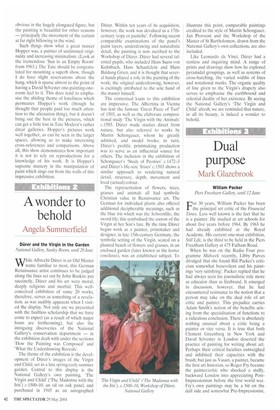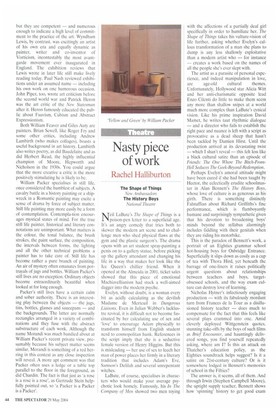Dual purpose
Mark Glazebrook
William Packer Piers Freetham Gallery, until 72 June
Elor 30 years, William Packer has been l' the principal art critic of the Financial Times. Less well known is the fact that he is a painter. He studied at art schools for about five years before 1964. By 1963 he had already exhibited at the Royal Academy. His current one-man exhibition, Still Life, is the third to be held in the Piers Freetham Gallery at 475 Fulham Road.
When he was on the Radio Four programme Midweek recently, Libby Purves divulged that she found Bill Packer's criticism somewhat benevolent and his paintings 'very satisfying'. Packer replied that he had always seen his journalistic role more as educator than as firebrand. It emerged in discussion, however, that he had encountered resistance to the notion that a person may take on the dual role of art critic and painter. This prejudice carries Adam Smith's notion of the benefits arising from the specialisation of functions to a ridiculous conclusion. There is absolutely nothing unusual about a critic being a painter or vice versa. It is true that both Clement Greenberg in New York and David Sylvester in London deserted the practice of painting for writing about art. Perhaps their critical faculties outweighed and inhibited their capacities with the brush; but just as Vasari, a painter, became the first art historian, so Roger Fry became the painter/critic who shocked a stuffy, backward London into appreciating PostImpressionism before the first world war. Fry's own paintings may be a bit on the dull side and somewhat Pre-Impressionist, but they are competent — and numerous enough to indicate a high level of commitment to the practice of the art. Wyndham Lewis, by contrast, was excitingly an artist of his own era and equally dynamic as painter, writer and co-inventor of Vorticism, incontestably the most avantgarde movement ever inaugurated in England. The exhibition reviews that Lewis wrote in later life still make lively reading today. Paul Nash reviewed exhibitions under an assumed name — including his own work on one humorous occasion. John Piper, too, wrote art criticism before the second world war and Patrick Heron was the art critic of the New Statesman after it. Heron famously educated the public about Fauvism, Cubism and Abstract Expressionism.
Both William Feaver and Giles Auty are painters. Brian Sewell, like Roger Fry and some other critics, including Andrew Lambirth (who makes collages), boasts a useful background in art history. Larnbirth also writes poetry, as did Baudelaire and as did Herbert Read, the highly influential champion of Moore, Hepworth and Nicholson in the 1930s. You could argue that the more creative a critic is the more positively stimulating he is likely to be.
William Packer specialises in still life, once considered the humblest of subjects. A cavalry battle in a history painting or a shipwreck in a Romantic painting may excite a sense of drama by force of subject matter. Still life painting may more easily be a form of contemplation. Contempla-tion encourages mystical states of mind. For the true still life painter, historical and literary connotations are unimportant. What matters is the colour, the tonal balance, the brush strokes, the paint surface, the composition, the intervals between forms, the lighting and all the other technical problems a painter has to take care of. Still life has become rather a pure branch of painting. An air of mystery often emanates from portrayals of jugs and bottles. William Packer's still lives are no exception. Ordinary objects become extraordinarily beautiful when looked at for long enough.
Packer's still lives have a certain calm and sober authority. There is an interesting play between the objects — the jugs, tins, bottles, glasses and saucepans — and the backgrounds. The latter are normally rectangles arranged in a variety of combinations and they fuse with the abstract substructure of each work. Although the name Morandi was much bandied about at William Packer's recent private view, presumably because his subject matter seems similar. Morandi is something of a red herring in this context as any close inspection will reveal. A more apt comment was that Packer often uses a ledge or a table top parallel to the floor in the foreground, as did Chardin. The fact is that just as 'a rose is a rose is a rose', as Gertrude Stein helpfully pointed out, so 'a Packer is a Packer is a Packer'.



































































 Previous page
Previous page